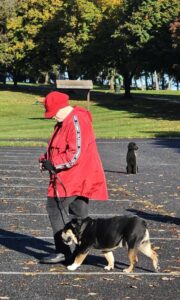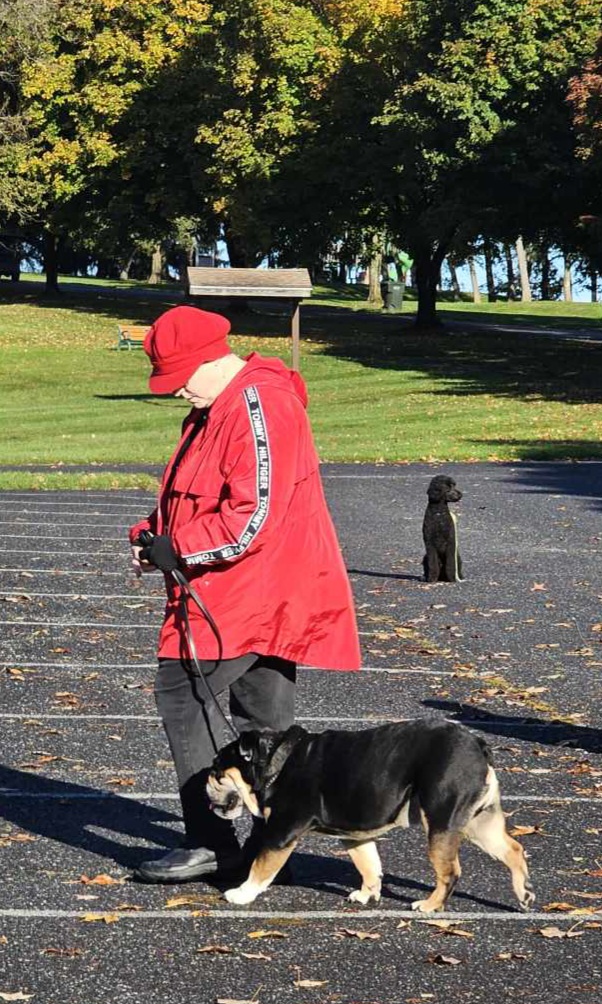 We talk in terms of reinforcement and punishment all the time. We understand the concepts behind adding something to make something happen (or stop happening) or taking something away to make something happen (or stop happening).
We talk in terms of reinforcement and punishment all the time. We understand the concepts behind adding something to make something happen (or stop happening) or taking something away to make something happen (or stop happening).Well, they don’t.I’ll even go as far as to say that dogs actually learn faster if they make these discoveries on their own.
We all know the dog that gets its panties in a twist when the owner breaks out the jogging shoes and the leash. Through the power of predictability, the dog has learned that certain things, in a certain order of appearance, can only mean the dog and its owner are getting ready to embark on an activity the dog looks forward to.
These ritualized predictors are powerful signals to a dog and can be exploited in a variety of ways. They are usually very well-developed before the owner recognizes the issue, and they become incredibly resistant to extinguish.
As my friend and fellow trainer Nate Czarnota of Baltimore DogWorks has said a time or two, “Give me at least half the time it took for the dog to develop the behavior, in order to fix it.”
He’s not wrong. Moreover, regardless of what direction of the emotional spectrum the dog aligns the presence of that predictor to, it will impact the strength of the dog’s reaction to its presence.
A fearful dog will seek opportunities to escape. A bold dog will seek opportunities to investigate.
We see it attached to all types of behaviors.
I currently have clients with dogs that become inconsolable in the presence of their owners’ car, toys of a specific color, several other triggers that each dog has been conditioned to recognize as a predictor to a specific form of self-reinforcement or self-correction, simply because the presence of those predictors in a specific sequence of appearance have indicated that object, activity or other event is inevitable.
That’s the key, and it’s also the key to breaking the cycle that previously terminated with that reinforcer.
Dogs that get to engage in bite sports are rewarded with the opportunity to bite. It is a powerful reinforcer. Dogs that are trained to retrieve, are reinforced with the opportunity to retrieve. Dogs that hunt… well, you get the picture.
Companion animals are generally denied access to express genetic drives. What the working dog trainer wants in their dog, the companion animal owner usually doesn’t or works hard to control, extinguish, redirect or otherwise disable.
As a result, companion dogs tend to develop a lot of “anticipation anxiety” associated with specific events, and the predictable triggers that signify that event is on the horizon.
Owners tend to create predictors without even knowing it. I guarantee your dog knows what’s going to happen the second your alarm goes off in the morning, with a high rate of accuracy. I am even willing to suggest that they know what foot hits the floor first, and whose foot it is.
So, we can use this knowledge to frame behavior. Both behaviors that we want to see repeated, and behaviors we wish to extinguish.
We just have to remember what the goal is, and how to make it easy for the dog to succeed.
It doesn’t take much, really. No big explanations of “bMod” or other BS, just the tacit understanding that we can use what the dog wants against him in the operant sense. It’s all reinforcement and punishment.
What people don’t have is the patience to work with the 4-year-old dog that has persistently dragged its owner through the parking lot on its hind legs to escape whatever terrors it perceives, because it has been a successful strategy to escape or avoid those things it doesn’t enjoy. People choose to use leveraging devices in order to facilitate that process, but what they generally end up doing is trading one stressor for another.
If I bang the dog with a collar correction (pick your device, the result is the same for any of them), the neurons that fire will pair the new event and layer (stack) new trauma to old events. You may achieve better control to the car, but you have not changed your dogs mind about the events leading up to its arrival there.
If the dog I am working with wants to escape his surroundings and scrabble towards my car because he perceives safety in its presence, I am going to deny him access to it, until he walks politely at my side (initially, I’ll settle for just -not pulling-). I don’t have to add anything to the equation. All I have to do is deny the dog access until he understands that access is unavailable until he assumes a calmer state.
How long does that take? It takes what it takes. I can stand like a statue for hours. I am going to reward successive approximations of the behavior I wish to encourage until we accomplish the task, and believe it or not, when I start, I am right next to the trigger. I am not a football fields’ length away. I don’t need to be. I just need to create desire in the dogs’ mind.
Going to the park to ‘socialize’ your dog isn’t working for dogs like this, if the end result is your dog dragging you to the car at the end of each training session.
What *will* work is practicing that approach in a less stressful environment, and being more aware of the signals that your dog has been stacking along that path of arousal, waiting for the signal that gives him permission to pull your arm out of its socket on the way to his emotional sanctuary.
Your ecollar isn’t going to stop that. Neither is your prong collar. All of that additional pressure will actually increase your dog’s desire to escape that which is behind him, in favor of that which he has been guaranteed, and lies ahead of him.
Because the outcome is inevitable. Every time. Your dog knows this. He gets to win regardless of the struggle you may have with him. He has never been denied access to his conditioned reinforcer.
It’s never too late to start synaptic pruning your dog’s response to emotional triggers!

